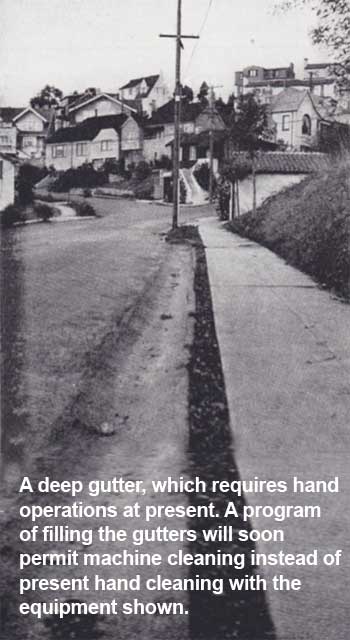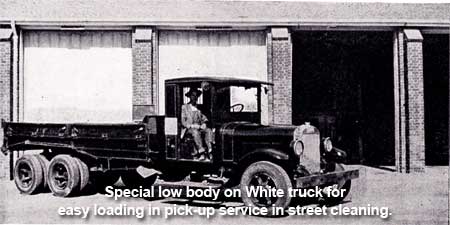The History of the Sweeping Industry |
Street Cleaning Practice in Berkeley, California 1941The Routine? Hand Sweeping, Collection Truck and Deep Gutters...
This article was originally published in The American City, April, 1941 The Department of Public Works of Berkeley, California, is divided into three bureaus, one of which, the Bureau of Streets, has two divisions: Street Maintenance and Sanitation. The Division of Sanitation includes the maintenance of sewers and the cleaning of streets. Street sweeping is done entirely by hand, but it is anticipated that mechanical power sweeping equipment will be purchased in 'the near future.' There are 22 men actively engaged in sweeping the streets. The sweepings are collected by three trucks working full time and one truck working part time. Each truck has a helper and a driver, in addition to the regular 22 men who sweep the streets. 
Residential Streets
A distinction is made between the macadam streets in the residential districts and the hard-surface streets in the business district. The macadam streets in the residential districts are cleaned, on an average, fifteen times during the year. Over a period of eleven years, the number of times the streets have been cleaned has increased from eight to fifteen per year. These tabulated costs include sweeping, collecting and hauling to the dump, but do not include depreciation or interest on the investment. The expenditure per month for street cleaning varies during the year. It has been found that the expenditure in July, per mile of street, is approximately $11, whereas, during March and April, the cost is approximately $9 per mile. Over a period of 5 years the average length of street cleaned per man per day is 0.93 miles. Some men sweep as little as 3,200 feet per day, and other sweepers cover as much as 8,300 feet per day. Business StreetsTwenty-eight miles of permanently paved streets have been patrolled by 10 men sweeping by hand. Business districts have been patrolled from four times per day, in the downtown section, to once per day, in the outlying business districts. Certain main business centers are cleaned every day of the year, including Sundays and holidays. Because of the congestion due to the parking of automobiles, the street sweepers begin at 3:30 o'clock in the morning in the downtown sections, and 6:00 o'clock in the morning in the outlying districts. The cost per mile on permanently paved streets is $1.59 and varies with the conditions to be met. A street-cleaning problem in Berkeley, Calif.-A deep gutter which requires hand operations at present. A program of filling the gutters will soon permit machine cleaning instead of present hand cleaning with the equipment shown. 
Berkeley's Gutter ProblemMany of the existing gutters are of the old type or design, when most of the water was carried in the gutters. Owing to the depth of these gutters, it is practically impossible to clean them properly by using mechanical or power sweepers. As funds become available, these deep gutters are being filled so that the depth of the gutter is not more than 8 inches below the top of the curb. The mileage available where mechanical sweeping equipment may be used is increasing each year, and it is expected that a more satisfactory job of street cleaning will be done in the near future, when a power sweeper is purchased. Present Collection Units
A special type of body was developed for a truck to lessen the labor by reducing the height that the street pick-up cans had to be raised in order to empty them into the truck. The sides of the body are hinged and drop down until the truck is filled to this point. Then, the sides are raised and fastened in place to take care of the rest of the load. This type of equipment has proved very satisfactory. The cans into which materials are deposited by the men are placed on the front part of a buggy. The large broom is used for sweeping an area adjacent to the curb and approximately 6 feet wide. The other small tools, including the small broom, are used in cleaning around the entrances to culverts. The buggy has rubber tires. 
A large blow-torch is used to burn the weeds which grow up between the rocks in the deep gutters. These types of gutters were constructed many years ago and most of them have been removed in the program of modernization.

Thanks to long-time Berkeley citizen activist, L.A. Wood, of BerkeleyCitizen.org for contributing this article for archiving at WorldSweeper.com. Also, we're always on the lookout for more sweeper-oriented information we can add to the website, so let us know if you find interesting historical information about sweeping. |
© 2005 - 2021 World Sweeper
|
Back to History of the Sweeping IndustrySite Map / Table of Contents |